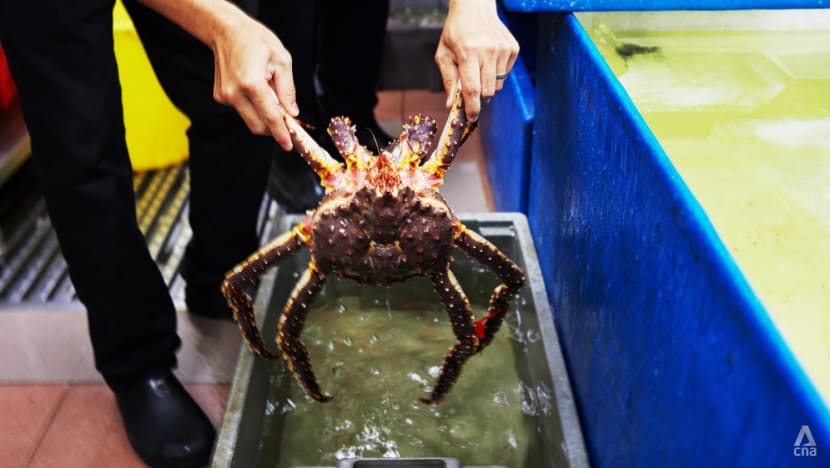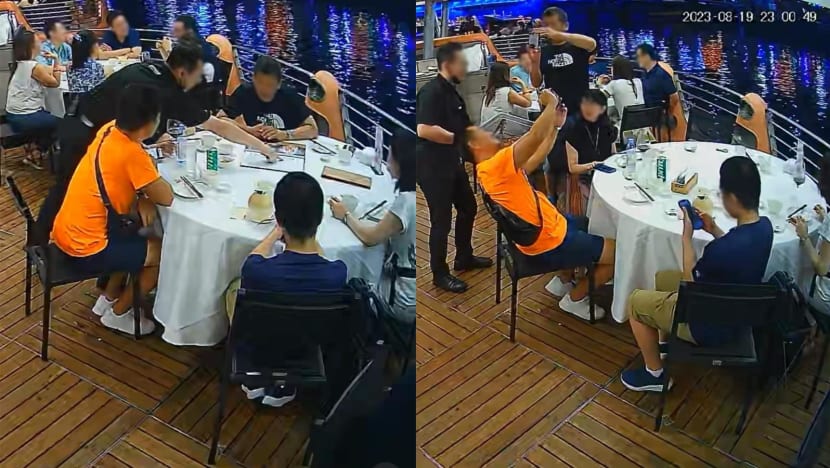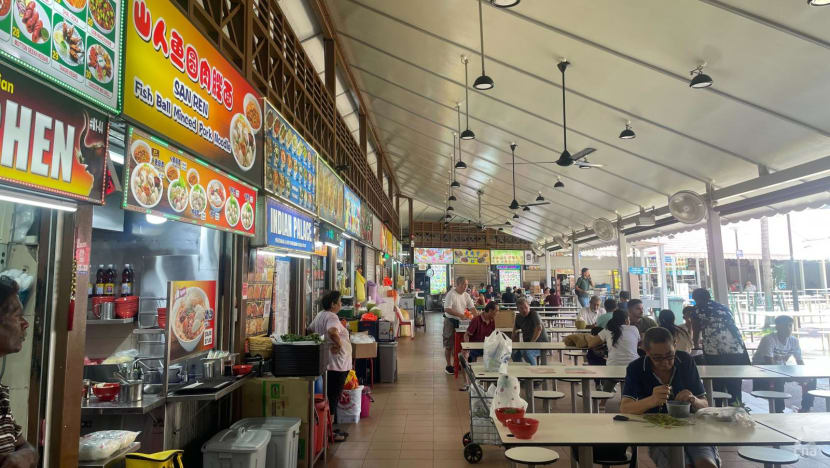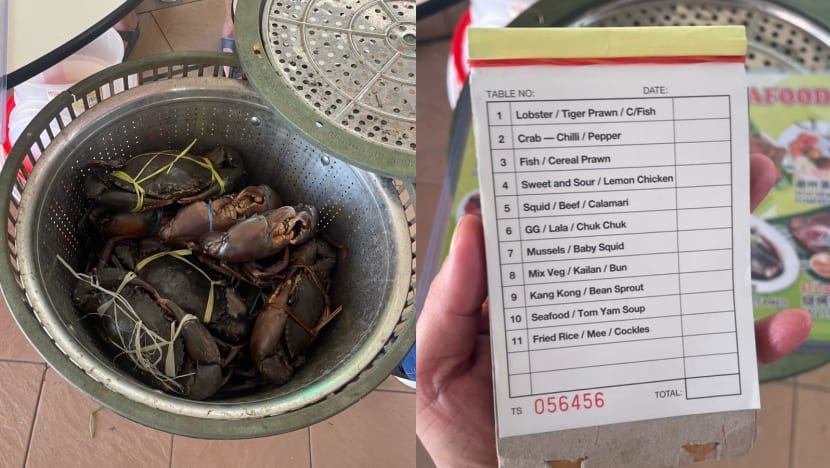No conflict, please: Restaurant operators say staff trained to confirm prices when diners order seafood
Last month, Paradise Group rejected allegations by a tourist that it overcharged her group for a chilli crab dish. CNA spoke to restaurant operators and hawkers to find out their sales guidelines and how they communicate prices to diners.

SINGAPORE: When selling live seafood like crabs and crayfish, staff are trained to inform prospective diners of the prices before they decide to purchase the dish – especially if it is sold by weight, restaurant operators and hawkers told CNA.
Some also said they offer a tentative bill in writing so that customers cannot dispute the price of their meal after they are done eating.
This comes after restaurant operator Paradise Group, which runs Seafood Paradise at Clarke Quay, rejected allegations by a Japanese tourist last month that she was overcharged for an Alaskan king crab cooked chilli crab-style.
The tourist, Junko Shinba, alleged that the waiter strongly recommended a particular type of crab for S$30 but did not explain that it charges per 100g.
She also said they were not told of the total weight of the crab before it was cooked. Her group of four diners was charged S$938 (US$685) for the dish, with the total bill coming up to S$1,322.37.
Ms Shinba said she asked a waiter to call the police. After the restaurant manager offered a discount of S$107.40, Ms Shinba's friend paid for the meal with his credit card.
Paradise Group then took to Facebook to say its employee had twice informed the diners of the price of the Alaskan king crab per 100g and its total weight while they were placing their order. The operator also released CCTV screenshots to substantiate its statement.
Ms Shinba contacted the Singapore Tourism Board, which in turn brought the matter to the attention of the Consumers Association of Singapore (CASE).
BUSINESSES SHOULD CLEARLY COMMUNICATE PRICES: CASE
In response to queries from CNA, CASE president Melvin Yong said that the consumer watchdog has received five complaints against seafood restaurants so far this year.
It also received the same number of complaints last year, up from one complaint in 2021 and three in 2020.
In general, customers had gripes about the prices they were charged for seafood dishes, while some complained they were not told of the prices when they placed their orders.
Some consumers also said they were charged separately for Goods and Services Tax (GST) and service charge, despite the menus stating that these were already included in the prices.
Mr Yong noted: “In general, CASE is of the view that the onus is on businesses to clearly communicate prices and any GST and/or service charge to consumers and obtain their consent before proceeding.
“As a matter of good business practice and transparency, restaurants may wish to provide a tentative bill in writing for consumers to confirm their orders to avoid unnecessary disputes which may subsequently arise, especially for seafood items that are marked as 'market price'.”
CASE has also developed a set of best practices to guide businesses on how to display prices and communicate price changes to consumers.
Mr Yong said that consumers, on their end, should check the market prices of seasonal items before going ahead with their orders.
In particular, they should confirm the unit of measurement for prices quoted, the weight of the seafood items and the total amount payable, he added.
WHAT BIGGER CHAINS SAY
CNA contacted several larger seafood restaurant chains for comment.
A spokesperson from TungLok Group, a popular Chinese restaurant chain that operates several seafood restaurants across Singapore, said its restaurant staff are trained to let diners know the price per 100g and the price of the entire dish after it is weighed. This applies to all dishes that are charged by weight.
“This is to ensure that diners are fully aware of how much they are paying to avoid any conflict when they pay the bill at the end of the meal,” she added.
Two of TungLok Seafood’s outlets are located at Gardens by the Bay and Orchard Central shopping mall – areas that are frequented by tourists.
An Alaskan king crab, cooked chilli crab-style, was listed at a “market price” on its menu at these outlets. It was similarly listed at a “seasonal price” on the menu of Seafood Paradise.
The TungLok spokesperson said that at its other restaurants that get more tourists, such as TungLok Heen at Resorts World Sentosa, the price of a dish as a whole is clearly stated on the mobile ordering system.
Jumbo and Long Beach, which also have restaurants along the Singapore River, did not respond to CNA's queries.

Over at House of Seafood, its chief executive officer Vincent Ng told CNA it has a standard operating procedure – staff will show diners the crab or seafood they have ordered before preparing the dishes.
House of Seafood runs two outlets at The Riverwalk and Punggol.
Mr Ng said that the Riverwalk outlet receives “a lot” of tourists. If they are from China, for example, he gets staff who speak Chinese to serve them.
However, if customers speak a language that none of the staff is familiar with, they will use the Google Translate mobile app to communicate with customers, Mr Ng added.
Staff also advise customers on the meat quality and which country the seafood originated from, as well as the price of the dish.
House of Seafood charges per 1kg for seafood dishes. Mr Ng said those that charge per 100g want to "lure customers" with a "marketing tactic" to make a dish seem cheaper than it really is.
He gave an example of a customer wanting to purchase a 2kg crab.
"I will tell them how much it is – 1kg is S$90 for example, so it costs S$180, but we will tell them this excludes GST and service charge. If they say everything is okay, then it’s good enough," he said.
"(If some people say) this crab doesn't weigh 2kg, then we'll invite them to the kitchen or we'll bring out the weighing scale to show them."
Mr Ng also said the restaurant now displays its crabs outside instead of keeping them in the kitchen, so that customers can choose what they want to order.
“At Riverwalk there, along the Singapore River … Everybody is fighting for the space. They want the business there and tender for it.
"The rental is super high, so the business drops and the manager is thinking of all sorts of ideas to get customers.”
He said he believes Seafood Paradise did not overcharge the tourists but fell into a misunderstanding with the group of Japanese tourists.
Disputes like these are frequent in areas like Boat Quay that are frequented by tourists, he added.
NEWTON FOOD CENTRE
Some hawkers at Newton Food Centre told CNA that they write down the prices of dishes that prospective diners are interested in. They then hand over the tentative bill to the diners before preparing the orders.
The hawker centre, which houses several seafood stalls, is also popular among tourists due to its central location, ambience and variety of local fare.

A part-time waitress at the Pirate’s Seafood stall said the current market price for a crab around 700g – which can be cooked in four styles – is between S$40 and S$50.
Crabs, lobsters, crayfish, Hong Kong steamed sea bass and Teochew steamed pomfret were among the dishes listed at "market price" on its menu.
The waitress added that while the stall used to charge diners per 100g for crabs, they began following their competitors in charging a flat rate depending on the size of the seafood. For example, a smaller crab will cost S$40.
She did not wish to be identified but said she has worked there for more than 10 years. She showed CNA a copy of the bill that she gives to customers before they decide whether or not to go ahead with their order.

A worker at another stall, Mr Teo Chin Leong, said the crabs that Newton Food Centre hawkers receive from suppliers now come in a standard size – between 600g and 800g.
The stall now sells crabs for S$50 each regardless of the specific weight, instead of per 100g.
“Everyone is doing this now,” said Mr Teo in Mandarin.
“If a customer wants to weigh the seafood, we can weigh ... If a tourist comes (to buy crab), I will say, believe me, it’s worth it."
The 60-year-old said he has been in the seafood business for about 35 years, with more than a decade at Newton Food Centre. He added that crabs have become “very expensive” and that the price he charges is “very cheap already”.
The stall still sells crayfish for S$5 per 100g because they are easier to sell and weigh, Mr Teo said.
The operators and stall owners said they do not give staff a commission for selling more expensive dishes. House of Seafood rewards employees with incentives if sales are good at the outlet where they work, said its CEO Mr Ng.
He added that he wants his staff to start wearing body-worn cameras to reduce the potential for disputes with customers, but he first has to check if this breaches the Personal Data Protection Act.
Mr Ng also advised all restaurants to have good CCTV cameras that can "capture every angle".
“My message to all the F&B (businesses): Be honest, tell them the true price, nothing to hide. Eventually, you still have to bill them this amount.”

















